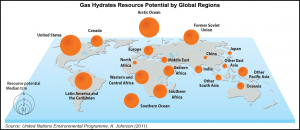- Natural gas hydrates are a naturally occurring, ice-like combination of natural gas and water. They are mainly found in oceans and Polar Regions
- Gas hydrates are crystalline form of methane and water, and exist in shallow sediments of outer continental margins. They are envisaged as a viable major energy resource for future.
- Promising sites of gas hydrates have been identified and surveyed in the Krishna‐Godavari (KG) and the Mahanadi basins
- Methane gas hydrate is stable at the seafloor at water depths beneath about 500 m.
- Known as flammable ice, methane hydrates are molecules of gas contained in an ice matrix found in permafrost regions of the arctic and on the seafloor at continental margins below 500 meters of depth.
- Gas hydrates are also important for seafloor stability studies, because “melting” gas hydrate may cause seafloor “land” slides.
- Using methane from gas hydrate as an energy resource would be, compared to other hydrocarbons, relatively climate friendly as combustion of methane is twice as efficient as burning coal.
- Why in news? India – US joint expedition discovers natural gas hydrates in Indian ocean
Why they are important?
- The amount of gas within the world’s gas hydrate accumulations is estimated to greatly exceed the volume of all known conventional gas resources.
- In India, gas hydrate resources are estimated at 1,894 trillion cubic meters (tcm) and these deposits occur in Eastern, Western and Andaman offshore areas
